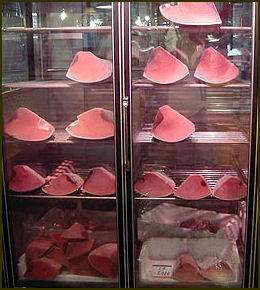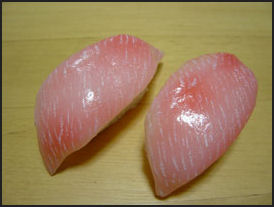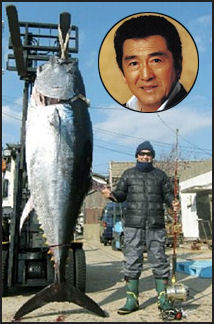Home | Category: Commercial and Sport Fishing and Fish
BLUEFIN TUNA AS FOOD

sushi Bluefin is the most valuable fish in the world. The most expensive sushi is made with fatty meat, know as “toro”, from the belly. The rest of the fish is called “maguro”. Skipjack, yellowfin, albacore and big eye tuna are generally worth 10 to 15 times less than bluefin. Generally tuna found in can is made from one of these fish. The best toro is pinkish, orange in color Sushi restaurants can purchase a special oil that can be applied to cheap, dark red toro so pass of it off as expensive toro.
Adam Yamaguchi and Zach Slobig wrote in the Los Angeles Times: "Otoro" (fatty tuna) is the filet mignon of sushi. Atop a small mound of rice, a heavily marbled slice of fish sits precariously “ so oily that it's on the verge of falling apart. With one bite, the exquisite cut of bluefin will melt into oblivion. Bluefin tuna may not be a household name, but its taste and texture are famous “ and increasingly infamous “ among sushi aficionados across the world. Hailed as the finest cut of tuna sashimi, the oily, fatty belly of the bluefin has also found its way onto many do-not-eat lists among consumers and environmentalists because the fish's numbers have plummeted in recent years. [Source: Adam Yamaguchi and Zach Slobig, Los Angeles Times, July 21, 2011]
Explaining the finer points of bluefin tuna buying, Hiroyasu Itoh, a buyer for a famous fish wholesaler, told National Geographic: "Why is that Americans think any fish is just like every other fish. They're not made in a factory, you know. It seems perfectly obvious to us that a bluefin from the cold, rough seas around Tasmania will have a different meat than a bluefin from tropical waters. I guess if you cook your tuna with lemon and seasoning, then it all starts to taste the same. But's that another thing I can't understand." [Source: , T.R. Reid, National Geographic]
One study found that in forth of the tuna sushi sold in restaurants in New York City contained high levels of mercury.
Websites and Resources: “Netting Billions 2020: A Global Tuna Valuation, Pew Charitable Trusts”, October 6, 2020 pewtrusts.org; Animal Diversity Web (ADW) animaldiversity.org; National Oceanic and Atmospheric Administration (NOAA) noaa.gov; Fishbase fishbase.se ; Encyclopedia of Life eol.org ; Smithsonian Oceans Portal ocean.si.edu/ocean-life-ecosystems
See Separate Articles: SUSHI: HISTORY, CHEFS, KNIVES AND KAITEN SUSHI factsanddetails.com ;TUNA: CHARACTERISTICS, SPEED, BEHAVIOR, FEEDING ioa.factsanddetails.com ; BLUEFIN TUNA: CHARACTERISTICS, BEHAVIOR, HUNTING AND MATING ioa.factsanddetails.com ; BLUEFIN TUNA SPECIES: ONE IN THE PACIFIC, ONE IN THE SOUTH, TWO IN THE ATLANTIC ioa.factsanddetails.com ; BLUEFIN TUNA COMMERCIAL FISHING ioa.factsanddetails.com ; BLUEFIN TUNA FISH FARMING ioa.factsanddetails.com ; LOW BLUEFIN TUNA NUMBERS: OVERFISHING, ORGANIZATIONS, QUOTAS AND PROTESTS ioa.factsanddetails.com
Bluefin Tuna and Japan

magaro hunks on sale in Tsukiji More than 80 percent of the global bluefin tuna catch is consumed in Japan. Bluefin imports increased from 340 tons in 1970 to more than 20,000 tons in 2008, with Japanese trading firms often purchasing a vessel s entire catch. Consumption reached 44,000 tons in 2006 with domestic production accounting for less than 15,000 tons. Japanese consume more 25 percent of the world s catch of all species of tuna. Not surprisingly Japan is the world s largest importer of tuna. It imported 36,989 tons in 2005.
About 1,200 fishing boats engage in oceangoing, long-line tuna fishing worldwide. Ninety percent of these are from Japan, China, South Korea and Taiwan. These vessels often stay out at sea for about a year, conducting only a couple of catches during that time.
Omamachi in Aomori Prefecture in northern Honshu is famous for its bluefin tuna. The tuna from here smells and tastes good and is soft and easily absorbs soy sauce. Firm tuna repels soy sauce. The best Bluefin tuna from here is caught in the fall and has a muscle temperature between 40 degrees F and 45 degrees F. It fetches the highest prices, around ¥20,000 per kilogram.
Bluefin Tuna
Bluefin tuna is the most prized of all tuna species. Hundreds of the treasured bluefin tuna arrive in Japan each day, each longer than a man and weighing 200 to 1,000 pounds. The best quality fish is caught in the late fall or winter when the water temperatures are low and the fish have a lot of fat to keep the, warm. The ideal water temperature is around 11 degrees to 16 degrees C.
Japan consumes three-quarters of the global catch of bluefin, a highly prized sushi ingredient known in Japan as "kuro maguro" (black tuna) and dubbed by sushi connoisseurs the "black diamond" because of its scarcity. "You know, good things like this are appreciated in the whole world," 22-year-old male customer Hirotaka Higurashi told the Los Angeles Times when asked about the overfishing issue. "There is nothing we can do about it."
The bluefin tuna is one of the world's largest and fastest fish. A predator that preys on smaller fish like mackerel, it can reach speeds of 55mph. The largest bluefin tuna ever caught was 32-year-old beast that weighed 1,496 pounds. The only predators observed feeding on bluefin tuna are mako sharks and killer whales.
At Nishinomiya Shrine in Nishinomiyama Hyogo Prefecture people press coins onto a frozen tuna and pray to Ebisui, the deity of wealth and commerce.
Bluefin Tuna Sushi

plastic toro Bluefin tuna is regarded as the premier sushi fish. One restaurant owner in Tokyo told the Washington Post, Tuna is the sushi in a sushi restaurant. If you have good tuna, you have a reputation of being a proper restaurant.” A single bite of meat from the belly of this fish can cost $40 in a sushi bar. Virtually all the bluefin tuna in Japan is eaten raw and people from different parts of Japan have different preferences. In Kyoto people reportedly like reddish bluefin tuna meat; in Yokohama, pink; Osaka, oily; and Tokyo, bright red. [Source: T.R. Reid, National Geographic. November 1995]
One long-time Japanese resident told National Geographic, "Fresh bluefin at the peak of autumnal fattening, cut paper-thin and eaten raw, provides an experience for which the Japanese have a vocabulary of distinctions as exquisite as that of the French for Bordeaux wines." Bluefin tuna hasn’t always been popular. In the Edo Period many Japanese regarded it as too greasy and often threw away the fatty “toro” portion.
The most expensive sushi is made with fatty meat, know as toro, from the belly. The rest of the fish is called maguro. Skipjack, yellowfin, albacore and big eye tuna are generally worth 10 to 15 times less than bluefin and generally tuna found in can is made from one of these fish. The best toro is pinkish, orange in color Sushi restaurants can purchase a special oil that can be applied to cheap, dark red toro so pass of it off as expensive toro.
Large and Expensive Bluefin Tuna
 In January 2009, a tuna caught off Omamachi was sold for $100,000. It was purchased by a Hong Kong businessman and the owner of Kyubei, a high-class sushi restaurant in Ginza. The restaurant owner said, “I’m getting a lot of advertising from the media coverage of the sale.” Tuna sushi sells for $16 a piece at Kyubia. Sushi made from the $100,000 fish was sold for $20 a piece, An auctioneer at Tsukiji told the Daily Yomiuri, “Sometimes, buyers compete for pride, which can result in extremely high prices...But in most cases, [the high prices] are aimed ay attracting advertising after being picked up by the media.”
In January 2009, a tuna caught off Omamachi was sold for $100,000. It was purchased by a Hong Kong businessman and the owner of Kyubei, a high-class sushi restaurant in Ginza. The restaurant owner said, “I’m getting a lot of advertising from the media coverage of the sale.” Tuna sushi sells for $16 a piece at Kyubia. Sushi made from the $100,000 fish was sold for $20 a piece, An auctioneer at Tsukiji told the Daily Yomiuri, “Sometimes, buyers compete for pride, which can result in extremely high prices...But in most cases, [the high prices] are aimed ay attracting advertising after being picked up by the media.”
In January 2011, a 342-kilogram bluefin tuna was sold at Tsukiji for a record price of ¥32.49 million ($360,000). The was caught off Toi, Hokkaido and fetched such a high rice because of its quality and freshness and the fact that bad weather reduced the New Year catch (538 bluefin were auctioned off, 33 fewer than the year before). The record-breaking fish was purchased jointly by Kyubei, a famous sushi restaurant in Ginza, and Itamae Sushi, a chain of restaurants in Japan and Hong Kong.
In July 2010, the largest bluefin tuna caught since 1986 was sold at Tsukiji. The 445-kilogram fish, which was weighed after it had been gutted and cleaned, was caught off Nagasaki Prefecture in Japan. It was auctioned off for ¥3.2 million ( ¥7,200 per kilogram). The largest bluefin tuna every sold at Tsukiji was a 496-kilogram fish caught in April 1986. The biggest bluefin ever caught was a 497-kilogram Canadian fish caught in 1995. The largest bluefin tuna ever caught with a rod and reel was a 32-year-old beast that weighed 1,496 pounds.
Single Bluefin Tuna Sold for Record $736,500
In January 2012, AFP reported: A deep-pocketed restaurateur shelled out nearly $750,000 for a tuna at Japan's Tsukiji fish market, smashing the record price for a single bluefin. The 269-kilogramme (592-pound) fish -- caught off the coast of Japan's northern Aomori prefecture -- stood at an eye-popping 56.49 million yen ($736,500) when the hammer came down in the first auction of the year. The figure dwarfs the previous high of 32.49 million yen paid at last year's inaugural auction at Tsukiji, a huge working market that features on many Tokyo tourist itineraries. [Source: Yoshikazu Tsuno, AFP, January 5, 2012]
The winning bidder was Kiyoshi Kimura, president of the company that runs the popular Sushi-Zanmai chain. At around 210,000 yen per kilogramme, a single slice of sushi could cost as much as 5,000 yen, but the firm plans to sell it at a more regular price of up to 418 yen, local media reported. "The flesh is coloured in magnificent red and the quality of fat is very good," Kimura said. "It is very delicious. The taste is unbeatable." A Hong Kong sushi restaurant owner bought the previous year's record tuna, and Kimura added: "I wanted to win the best tuna so that Japanese customers, not overseas, can enjoy it."
Emiko Misumi, a 44-year-old woman who tasted a slice, said: "This tuna is so fatty and very delicious." "It was sweet even without sugar or sake. It was a very delicate sweet taste," said another female customer Noriko Nakai, 63.
Bluefin Tuna Sells For Record $1.76 Million in Tokyo in 2013
Tsukiji market in Tokyo Tiffany Hsu wrote in the Los Angeles Times: “’sensible business strategy wasn’t really top of mind for Tokyo sushi chain Kiyomura K.K. when it shelled out $1.76 million for a single 489-pound bluefin tuna. The company dropped a record 155.4 million yen for the honor of buying the first fish up for auction at the famed Japanese seafood mart Tsukiji Market. The bid was nearly three times the 56.49 million yen high set by Kiyomura last year, according to market data. The chain snatched the record set in 2011 by a Hong Kong bidder. The company will serve the fish at regular prices of 128 to 398 yen “ or $1.47 to $4.56 “ per piece at its Sushi Zanmai restaurants, according to the Japan Times. [Source: Tiffany Hsu, Los Angeles Times, January 7, 2013]
Kiyoshi Kimura owns the Sushi Zanmai chain of restaurants in Japan. The price he paid works out to around $3,600 per pound. Kimura set the same record in 2012 when he paid $736,000 for a 593 pound bluefin. Bluefin tuna is normally expensive, but the price here was also inflated because "restaurant owners...compete annually for the prestige of buying the year's first tuna" at Tokyo's Tsukiji fish market. Kimura apparently got in a bidding war with another restaurant owner, which is why this tuna cost so much more than last year's. [Source: Paula Forbes, Eater, January 7, 2013]
Chikuyo Tuna
Tuna raised on the farms described above are known as chikuyo tuna. One of the aims of the process is to increase the body fat on the fish. A high fat contents means that up to 70 percent of the fish can be sold as fatty, premium-priced toro (normally only 20 percent of a fish can be sold as toro). But a lack of exercise leaves the flesh overly soft and lacking in taste and texture.
Much of the toro sold in sushi bars is chikuyo tuna. It cost about half as much as wild tuna and ths has brought down the price of toro so that it can be enjoyed by ordinary consumers. Oversupply has caused prices to drop even further. Now toro is available for as little as ¥1,000 per kilogram compared to ¥5,000 per kilogram that it sold for in the Bubble Economy era in the 1980s.
The lower prices have meant that the best quality toro is now even available at conveyor belt sushi restaurants. Japan imported about 3,000 tons of chikuyo tuna 1995 and 35,000 tons in 2005.
Chikuyo tuna is known for being particularly fatty. When he first encountered the fish one sushi restaurant chef told the Yomiuri Shimbun , “The tuna was like a big chunk of fat. A real sushi lover would find the is tuna’s smell different from the flavor of wild bluefin tuna.” The fish have more fat and thus softer meat in part because they get less exercise swimming around in small enclosed spaces that wild fish do in the open sea.
In wild bluefin tuna 30 percent to 40 percent of the fish excluding the head is classified as toro. In chikuyo bluefin tuna the figures rises to 70 percent or even 80 percent.
Tuna in Japan
Japan leads the world in tuna consumption. It consumes one third of the world’s tuna production and 95 percent of the world’s toro. The United States consumes roughly another third. In 2003, about 458,000 tons of raw tuna was sold in Japan. Of this, 43 percent was caught in Japanese waters. The rest was imported. The consumption of raw tuna peaked in the early 1990s at around 528,000 tons.
A large amount of bigeye tuna is consumed in Japan, mostly in the form of sashimi. Yellowfin tuna is widely consumed in Japan in sashimi and sushi. Around 20,000 to 38,000 tons of the annual catch of 100,000 to 150,000 tons of the fish caught in central and western pacific is consumed in Japan. Because overfishing of the fish is regarded as a serious problem fishing experts have called for a 30 percent reduction of the yellowfin tuna catch,
Increasing Consumption of Bluefin Tuna as Food

Tsukiji site
Elizabeth Kolbert wrote in The New Yorker, “At one time, Atlantic bluefins were common from the coast of Maine to the Black Sea, and from Norway to Brazil. In the Mediterranean, they have been prized for millennia — in an ode from the second century, the poet Oppian describes the Romans catching bluefins in “nets arranged like a city” — but they are unusually bloody fish, and in most of the rest of the world there was little market for them. (Among English speakers, they were long known as “horse mackerel”). As recently as the late nineteen-sixties, bluefin in the United States sold for only a few pennies a pound, if there were any buyers, and frequently ended up being ground into cat food.” [Source: Elizabeth Kolbert, The New Yorker, August 2, 2010]
Then, in the nineteen-seventies, the Japanese developed a taste for sushi made with bluefin, or hon-maguro. This new preference, it’s been hypothesized, arose from their exposure, following the Second World War, to American-style fatty foods. The taste for hon-maguro was, in turn, imported back to the U.S. Soon, fishing for bluefin became so lucrative that the sale of a single animal could feed a family for a year. (Earlier this year, a five-hundred-pound Pacific bluefin went for an astonishing three hundred and forty dollars a pound at a Tokyo fish auction.) First, the big bluefins were fished out, then the smaller ones, too, became hard to find. Tuna “ranching,” a practice by which the fish are herded into huge circular nets and fattened up before slaughter, was for a time seen as a solution until it was shown to be part of the problem: as fewer bluefins were allowed to reach spawning age, there were fewer and fewer new fish to fatten.
Adam Yamaguchi and Zach Slobig wrote in the Los Angeles Times, “Though 90 percent of bluefin is consumed in Japan, sushi's popularity has exploded in the U.S. in the last 20 years, and with it came high demand for the fatty underbelly of the bluefin. But with diminishing numbers of wild-caught fish available, sushi chefs are turning to ranched tuna to fulfill the demand. [Source: Adam Yamaguchi and Zach Slobig, Los Angeles Times, July 21, 2011]
Image Sources: Wikimedia Commons, National Oceanic and Atmospheric Administration (NOAA)
Text Sources: New York Times, Washington Post, Los Angeles Times, Times of London, Yomiuri Shimbun, The Guardian, National Geographic, The New Yorker, Time, Newsweek, Reuters, AP, Lonely Planet Guides, Compton’s Encyclopedia and various books and other publications.
Last updated January 2023

